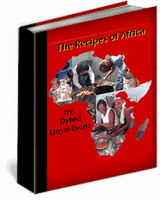Cook's Alphabet 'K'
This is the eleventh in my series of 28 postings going through the entire alphabet, as it relates to cooks and cooking. As you can see, today I'm dealing with the letter 'K'.
The letter 'K' is, of course the eleventh letter in the English alphabet, and today's recipe is for a classic Libyan dish of fish koftas:
Kufta Hoot (Libyan Fish Kofta) Recipe
Ingredients:2 large white fish fillets (about 250g in all)
3 slices of bread, crumbed
1 tsp kammon hoot
1/2 bunch of coriander (cilantro), finely chopped
1 onion, grated
1 tsp chilli powder
2 garlic cloves, grated
1 tsp baking powder
2 eggs, beaten
For frying:
1 egg, beaten
2 tbsp water
flour for coating
oil for deep frying
Method:
Remove any pin bones and skin from the fish then chop as finely as you can (the finer the better). Add the fish to a bowl along with all the remaining ingredients and use your hands to mix all the ingredients thoroughly and to bring everything into a ball. Tear off pieces of the mixture in your hands and roll into sausage shapes.
Add oil to your deep fat fryer or to a depth of about 4cm in your wok then whisk together the egg and water in a bowl. Dip the fish koftas in this then roll in flour to coat. Place in the oil and deep fry until golden and cooked through (about 6 minutes). Transfer to a plate and serve with rice, salad and hot sauce
(This recipe reproduced, with permission, from the Celtnet Libyan Fish Kofta Recipe page, part of the site's Libyan recipes page. )
Today's cooking term is Knead: Kneading is the process of orking a dough either by hand (or thesedays with an electric dough hook). The process aerates and makes the gluten proteins more elastic and produces a smoother dough. It also evenly incorporates air and any additional ingredients at the same time. The main function is to release the gluten molecules from the grain. These produce cross-links in the dough that both stabilize the dough and incorporate air molecules, allowing it to rise evenly.
Today's spice is the Kokam: Kokam (also known as Mangosteen are the fruit of Garcinia indica, a tree native to tropics of the Old World. Though the whole fruit is used as a spice (especially in the Maharashtra region of India) it is far more common to encounter the dried peel which has an acid taste and an agreeable flavour and is used as a souring agent (often in place of Tamarind) in curries and other dishes from the Coorg region of India. Kokam soup, in Indian medicine is often made for its healing properties and the recipe is given below:
Kokam Soup
Ingredients:
9 dried kokum fruit (or 20 pieces of kokum rind)
2 tbsp ghee
900ml water
1 tbsp coriander leaves, chopped
4 curry leaves
1/2 tbsp cumin seeds
1/4 tsp ground cinnamon
4 whole cloves
2 tbsp chickpea flour
2 bay leaves
1/2 tsp salt
2 large pinches black pepper
1 tbsp palm sugar (or demarara sugar)
Method:
Soak the kokam fruit in 240ml of water for 20 minutes, ensuring that you squeeze the fruit (or rind) several times to extract as much flavour as possible. Discard the kokum when done.
Heat a dry frying pan and toast the cumin and cloves until they release their flavour. Transfer to a pestle and mortar or coffee grinder and reduce to a fine powder. Meanwhile heat a saucepan and add the ghee. Once the ghee is hot add the ground spices, curry leaves, coriander and bay leaves. Cook for a minute then add the fruit water and 300ml water. Mix the chickpea flour with the remaining 250ml of water then add this to the soup.
Stirring continuously to prevent lumps, add the black pepper, salt and palm sugar. Still stirring, boil gently for five minutes. Serve immediately.
(This recipe, reproduced with thanks, from the Celtnet Kokam Soup Recipe page.)
For more information on cookery-associated terms and information beginning with the letter 'K' here are various links that may well be of interest:
Recipes beginning with 'K'
Spices beginning with 'K'
Herbs beginning with 'K'
Wild foods beginning with 'K'
Cook's glossary 'K'
For more African Recipes, see the Celtnet Recipes Blog African Recipes page.
This list of African regions and African recipes is brought to you in association with the Recipes of Africa eBook. With over 1000 recipes covering each and every country in Africa, this is the most comprehensive book of African recipes available anywhere.
If you love African food, or are just interested in African cookery, then the Recipes of Africa eBook is a must-buy. You get information about every region of Africa and every African country along with a selection of classic and traditional recipes from that country.
This is a must-get book for anyone interested in food. Learn about a continent that to this day remains mysterious to many people. The recipes presented here are written by someone who has travelled extensively in Africa and who is a published Author. The book is a properly-produce and published eBook and the collection is immense.
Don't delay, get yourself a copy of the Recipes of Africa eBook today!
If you love African food, or are just interested in African cookery, then the Recipes of Africa eBook is a must-buy. You get information about every region of Africa and every African country along with a selection of classic and traditional recipes from that country.
This is a must-get book for anyone interested in food. Learn about a continent that to this day remains mysterious to many people. The recipes presented here are written by someone who has travelled extensively in Africa and who is a published Author. The book is a properly-produce and published eBook and the collection is immense.
Don't delay, get yourself a copy of the Recipes of Africa eBook today!










